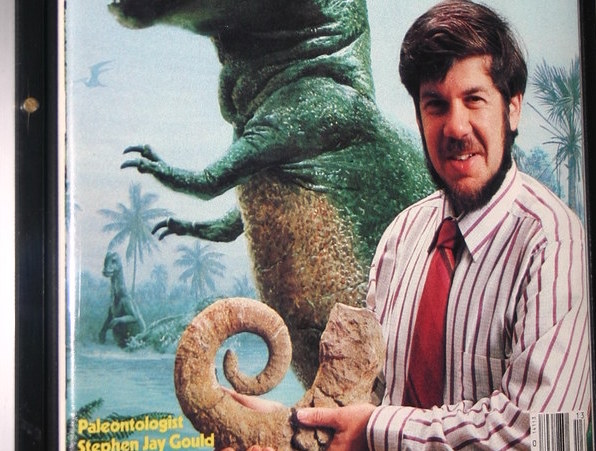Stephen Jay Gould is arguably the most widely read biologist in America and our unofficial "evolutionist laureate," according to the editors of Natural History. This fine publication of the American Museum of Natural History has printed hundreds of Gould’s essays, one a month for 25 years, most of which have been collected and republished in a series of popular books. Given the widespread creationist-inspired hostility to evolutionary science, one would expect Gould’s fellow evolutionary biologists to celebrate each new essay as it flies from Gould’s prolific pen.
In reality, however, many evolutionists believe that Gould has exercised his considerable skills as an essayist to misinform the public about research in evolutionary biology. At regular intervals over 25 years, Gould has used Natural History as a forum for attacking human sociobiology, and, more broadly, the adaptationist or selectionist approach in evolutionary biology, because that methodology is the foundation for sociobiological investigation. Although Gould’s polemical attacks have earned him public support as an "articulate (and rightly feared) enemy of sociobiological and hereditarian excesses,"1 His pronouncements on the adaptationist approach have been dissected and dismissed by a host of leading evolutionists.2 The vast majority of researchers currently interested in the possible adaptive value of the complex attributes, behavioral or otherwise, long ago put Gould’s strictures aside and have carried on with their work, which has been remarkably productive.
But because Gould is so hostile to human sociobiology, he has continued to try to undercut the selectionist philosophy that underlies that field by criticizing its application no matter what species is under study. For example, in "Only His Wings Remained," he launches a sweeping critique of adaptationist hypotheses in general:
Darwinian theory is fundamentally about natural selection. I do not challenge this emphasis, but believe that we have become overzealous about the power and range of selection by trying to attribute every significant form and behavior so its direct action. In this Darwinian game, no prize is sweeter than a successful selectionist interpretation for phenomena that strike our intuition as senseless.3
Although Gould says that "he does not challenge this emphasis," note that he wants his audience to believe that producing selectionist hypotheses is, in itself, a sign of "overzealousness," a waste of time for all concerned. Moreover, he would like his readers to think that selectionists, and by extension sociobiologists interested in human behavior, are satisfied with their untested interpretations of counter-intuitive phenomena, their "just-so stories," a denigration that Gould invented and has liberally applied to adaptationist research whether it deals with humans or not.
If Gould were able to convince his Natural History audience that overzealous and uncritical adaptationists consistently generated flawed hypotheses about animals other than humans, then he presumably would have an easier time convincing these readers that his campaign against human sociobiology is justified. In reality, persons who have studied adaptation in animal behavior have been willing to test their hypotheses rigorously, with the result that our knowledge of the evolutionary basis of behavior has been greatly expanded in the 25 years since the publication of Sociobiology. But before examining the behavioral research of adaptationists, we need to discuss two of the tactics that Gould uses to persuade persons unfamiliar with the actual research record that questions about the adaptive design of behavior can be safely ignored.
First, Gould claims that, in general, explanations of traits in terms of their immediate developmental or physiological causes—what are sometimes called "proximate explanations"—carry more weight than evolutionary explanations focused on the adaptive or reproductive value of these attributes. In effect, Gould is arguing that adaptationists can often be ignored because explaining how a characteristic of interest came into being via the developmental process or how the attribute is controlled by the animal’s internal physiological mechanisms makes it unnecessary to explain why natural selection resulted in the spread of the characteristic (and its underlying developmental and internal control mechanisms).
In making this case against adaptationism, Gould sets two levels of analysis—immediate developmental- physiological causes vs. long-term evolutionary causes—in stark and unnecessary opposition. For example, consider his treatment of the pseudopenis possessed by female spotted hyenas. The clitoris of these carnivores looks remarkably like a penis. It can be erected like a male hyena’s penis. It comes with a pseudoscrotum as well. But the female’s pseudopenis contains an access route to the vagina that is also the birth canal. Gould follows others in proposing that the pseudopenis originated as a side effect of elevated androgen levels in an ancestral female hyena. According to this scenario, androgen levels were the trait under selection, with females that had higher amounts of male hormones gaining a reproductive advantage of some sort, although just what that advantage might be is not yet certain. In any event, the fact that embryonic females come in contact with relatively high levels of male hormones means that their genitalia become masculinized. The general pattern for mammals is that if a female’s clitoral tissues are exposed to testosterone during early development, they will become enlarged and penis-like, even in species other than hyenas.
Gould contends that knowledge of this developmental process eliminates the need for further questions about the adaptive value of the pseudopenis: "Speculation about adaptive significance is a favorite, and surely entertaining, ploy among evolutionary biologists. But the question, ‘What is it for?’ often diverts attention from the more mundane but often more enlightening issue, ‘How is it built?’"4With this assertion, Gould jettisons a fundamental biological concept, namely that proximate and evolutionary levels of explanation are complementary rather than competitive. True, the genetic, developmental, hormonal, and other physiological mechanisms that individuals possess provide immediate or proximate explanations for their behavior. Evolutionary biologists, however, can still ask why species possess their particular proximate mechanisms and how these mechanisms spread after they once appeared in the species, questions that require an understanding of the history of the species—the evolutionary side of the equation.
Niko Tinbergen, the great student of animal behavior, first spelled out this point clearly in 1963, and it has been widely accepted ever since. But instead of helping his readers see the complementary relationship between the proximate and evolutionary levels of analysis, Gould claims incorrectly that they are mutually exclusive. In reality, scientists interested in proximate causes often identify mechanisms worth investigating by considering the evolutionary level of explanation. Thus, it was only after Kenneth Roeder discovered that some moths took successful evasive action when approached by night-flying, ultrasound-producing bats that he began his search for the neurophysiological system that provided the proximate foundation for the moth’s adaptive anti-predator behavior. He found an ultrasound-detecting mechanism among the nerve cells in the moth’s ear, which proved to be specially designed to promote a moth’s chances of surviving in a world full of bats.
Gould has also attempted to obscure the complementarity of proximate and ultimate causation in a discussion of the causes of female orgasm in our species.5Here too he asserts that one need not bother with selectionist research on the subject. His argument goes as follows. First, embryonic females have one kind of hormone-tissue interaction that produces the clitoris, the structure necessary for orgasm in adult females, whereas the same cells in males undergo another kind of hormone-tissue interaction that produces the penis. The penis and male sexual orgasm are of obvious adaptive utility to males; the clitoris and female sexual orgasm are merely side effects of the developmental systems that provide males with these adaptive attributes. According to Gould, one no more need explain female orgasm in adaptive terms than one need inquire into the adaptive value of male nipples, which arise because of their utility to females, not males. The proximate (developmental) explanation for female orgasm is all we need. To this end, he writes, "If anything, such developmental explanations are more expansive and operational than the necessarily fruitless and untestable selectionist speculations that continue to permeate our literature."6
• • •
This assertion is wrong. Proximate explanations of a biological characteristic do not make it impossible to ask whether the trait of interest contributed to individual reproductive success in the past or does so currently. If we were to discover that female orgasm has positive consequences for female reproductive success, we would gain an evolutionary dimension to our understanding of this trait that is not covered by any proximate explanation. The fact that female orgasm apparently can draw sperm closer to the cervix, and thus potentially affect the fertilization chances of an egg, is evidence of the kind of complex functional design that demands adaptationist analysis.
Gould has, however, an additional semantic argument intended to convince his readers that adaptationist analyses are irrelevant. His tactic is to define "adaptation" almost out of existence. Consider again the case of the spotted hyena. When he wrote his essay on these animals, Gould was fully aware that female spotted hyenas currently use the pseudopenis in various behavioral interactions with one another, raising the clear possibility that the structure has current adaptive utility. More recent research suggests that subordinate females use the pseudopenis to signal something, probably their acceptance of subordinate status, to dominant females. In so doing, the subordinates may improve their chances of survival and eventual reproduction. If so, the reproductive benefits associated with the pseudopenis would affect the strength of selection acting on the developmental mechanisms that are responsible for the production of the trait at the proximate level. In other words, demonstrations of current adaptive value would be relevant for understanding the current maintenance of the pseudopenis, just as they could be for understanding the persistence of the clitoris and female orgasm in women.
But Gould has a definitional solution for the problem posed by traits that currently advance individual reproductive success. He writes, with respect to the spotted hyena, "Once [a peniform clitoris and a false scrotum] are present, some use might be evolved for them—as in the meeting ceremony. But their current utility does not imply that they were built directly by natural selection for the purpose they now serve."7
No one denies that a trait’s current function may not be the same as it was originally. Indeed the original purpose of very few traits was the same as its present function. For example, the first "bird" feathers surely had nothing to do with flight, but were instead slightly modified reptilian scales of some sort with some other function. This historical fact is interesting and worth knowing. But to claim that today’s bird feathers are not adaptations is to imply that we do not have to pay attention to adaptationists on these or most other attributes of living things. Gould is eager to leave this impression, which is why he insists on calling bird feathers and most other traits "exaptations." But whatever you call the complex attributes of living things, if you wish to explore whether certain bird feathers are currently designed to promote efficient flight, you have to test adaptationist hypotheses of one sort or another.
Gould has tried on several occasions to define adaptations out of existence. Consider his treatment of parental decision-making by the blue-footed booby. This marine bird lays its two eggs several days apart, so that one chick hatches well before the other. The first hatched is therefore larger than its junior sibling, giving it the weight advantage needed to push the smaller, relatively helpless second chick out beyond the ring of guano that surrounds the nest. Parent boobies observe all this benignly, and although they will retrieve a youngster that is just outside the nest scrape, they ignore their own offspring if it pushed beyond the ring of guano. As a result, the smaller, second-hatched chick almost always dies right under the bill of its parent.
Decision-making by the booby therefore is regulated by a simple rule of thumb: inside the ring, treat the chick parentally, outside the ring, ignore the chick. Now, as Gould notes, the selectionist looks at this situation and proposes that the simple, instinctive reaction of the parent to its chick is actually reproductively superior to more complex decision-making modes. The bird looks to be behaving "stupidly," but in so doing, it winds up tolerating siblicide in an adaptive manner.
Gould acknowledges that tolerance of siblicide advances the reproductive success of the parent birds, which can only raise a single youngster to fledgling and so "should" invest in only one healthy growing chick. The adult birds let the chicks determine who will receive their parental largess. But Gould disagrees with those who say that instincts are an adaptation in this case. "Birds may have originally developed their brain, with its characteristic size, as an adaptation to life in an ancestral lineage more than 200 million years ago; the [use of simple rules of thumb] may be a nonadaptive consequence of this inherited design."8 He goes on, "The smaller brain and more limited neural circuitry of nonhuman animals must impose, or at least encourage, intellectual modes different from our own. These smaller brains need not be viewed as an adaptation to any prevailing condition."
The idea is that the history of birds imposes constraints on the evolution of bird brains, presumably because birds fly, which may favor individuals with relatively small, light-weight brains. According to Gould, this historical, structural constraint in turn imposes limits on the "intellectual mode" of birds. If they were freed from this constraint, birds could do better, intellectually speaking. Therefore, in some sense, reliance on simple instincts is less than optimal, and therefore the avian style of intelligence is "a nonadaptive consequence" of history. Gould merely asserts that his hypothesis is correct but does not offer any evidence on the matter, although relevant data exist, as I shall document. For the moment, I wish only to point to the definition of "adaptation" implicit in Gould’s argument. By "adaptation" he means a trait that evolved without historical constraints, which means that almost no trait qualifies for the title. And I think that this is essentially what he has in mind.
Gould’s combative repetition of anti-adaptationist arguments has influenced the general public’s "understanding" of those evolutionary subdisciplines that explore behavior, human or otherwise. Moreover, the fact that such a prominent evolutionist has so often denigrated sociobiological research and findings has made it easier for academic social scientists to ignore or dismiss the implications of evolutionary theory for their work as well. But while Gould’s essays have contributed to a certain uneasiness among sociobiologists at being labeled as such, his pronouncements have not seriously slowed work on the adaptive basis of animal behavior. In fact, adaptationist research has grown exponentially during the 25 years that Gould has been writing for Natural History. During this period, almost every article that has appeared there, other than Gould’s column, has been founded upon the adaptationist approach.
Evolutionists have a long and distinguished track record of success in identifying puzzles worth studying (any trait that seems to reduce the reproductive chances of individuals) and an equally long and distinguished record of testing alternative solutions to these puzzles. This rich record stands in stark contrast to Gould’s claim that adaptationists are satisfied with untestable speculations.
The fascinating nature of the discoveries of adaptationists can be illustrated with a few examples taken from topics that Gould raises in his essays. For example, adaptive sexual suicide of the sort sometimes attributed to male praying mantises (which are sometimes consumed by their mates) is, according to Gould, utterly implausible, not worth even speculating about. Irritated at Gould’s attempt to declare an interesting puzzle out of bounds, Maydianne Andrade went ahead and explored the evolution of similar behavior in the male redback spider. When the male contacts a receptive female, he aligns his body to hers in a particular way, begins to transfer sperm, and performs a backflip into the jaws of his copulatory partner. How can it be adaptive to deliver oneself into the jaws of death? Andrade found that if the female spider does consume the male, his sperm will fertilize more of her eggs than if he fails to become a sexual suicide. Females that have feasted on their small partner are less likely to mate again quickly and so are less likely to acquire new sperm for their eggs to compete with those of their now deceased mate.9
• • •
And what about avian decision-making? For Gould, bird brains come with historical constraints that ought to render birds intellectually deficient. The findings of other evolutionary biologists provide ample evidence on this point, with the result that we can reject the weak-brained, instinct-constrained image of birds that Gould conjured up. Many bird species have evolved adaptive learning abilities of great sophistication designed to overcome particular obstacles to reproductive success in their environments. For example, in those species that learn their songs by listening to others (the better to communicate with neighbors), an interconnected array of complex neural units has evolved to promote acquisition and modification of the song.10 Likewise, certain migratory birds have been shown to possess highly complex orientation mechanisms that can be fine-tuned via experience throughout the birds’ lifetime.
For those bird species that scatter small food caches widely through their environment, other specialized neural units provide the physiological foundation for exceptional spatial learning. For example, Russell Balda and Alan Kamil have demonstrated that Clark’s nutcrackers, which routinely store pine seeds in hidden caches across entire mountainsides, have an extraordinary capacity for long-term spatial memory. In the laboratory, some nutcrackers can remember specific locations where they hid food nine months previously.11 In yet another cluster of bird species, brood parasites, natural selection has produced another adaptive learning capacity, the ability to learn the location of potential host nests. Thus, female cowbirds remember where suitable nests are and come back so them when the host is at the appropriate stage to "adopt" the cowbirds’ egg. Female cowbirds have relatively more hippocampal tissue than males, an adaptive difference in neural design linked to the greater benefits of specialized spatial learning for females.12 Note once again the utility of selectionist thinking in guiding the search for complex proximate mechanisms that help solve very specific ecological problems. The knowledge that birds are not necessarily "bird brained" comes from application of the adaptationist approach.
For Gould, female orgasm in humans is currently the side effect of proximate developmental-physiological mechanisms, a nonadaptive side-effect "divorced from the Darwinian summum bonum of enhanced reproductive success,"13 an assertion that he made without any reference to data then available to him in the biological literature. The data have been collected by a number of students of human behavior, including Sarah Hrdy, Robin Baker, Mark Bellis, Randy Thornhill, and coworkers, in the course of testing alternative hypotheses on the possible current utility of female orgasm. Some evidence indicates that female orgasm may be a mechanism of cryptic female choice—that is, a device that enables women to influence the paternity of their offspring by selecting among the sperm of more than one copulatory partner, a fascinating hypothesis well worth exploring.14
Why does all this matter? Scientifically, Gould’s criticisms are largely without effect. As I write, hundreds of researchers are at work identifying and solving selectionist puzzles in animal behavior by putting their hypotheses to the test. Indeed, in the long run, I expect that Gould’s essays will be just an odd footnote in the history of science, the evolutionary component of which has been shaped in a wonderfully productive manner by adaptationism.
Yet at another level, Gould’s attacks do matter, for by virtue of the thousands who read his popular essays in Natural History and elsewhere, he continues to exercise influence on the public debate about such matters as how we can best understand our own behavior. In the short term, he may advance his anti- sociobiology cause by misrepresenting adaptationist research on animal behavior, but in the long haul our "evolutionist laureate" may find that the tactic backfires. When the public learns that sociobiologists have actually been able to make good evolutionary sense of the attributes of hyenas, cowbirds, blue-footed boobies, and redback spiders, perhaps they will become more receptive to the possibility that sociobiologists have something important to say about ourselves as well.
Notes
1 H. Allen Orr, "Gould on God," Boston Review (October/November 1999): 24.
2 For examples see R. D. Alexander, The Biology of Moral Systems (Hawthorne, NY: Aldine de Gruyter, 1987); Gerald Borgia, "The Scandals of San Marco," Quarterly Review of Biology 69 (1994): 373-375; J. Maynard Smith, "Confusion over Evolution: An Exchange," New York Review of Books (January 14, 1993): 43; D. C. Queller, "The Spaniels of St. Marx and the Panglossian Paradox: A Critique of a Rhetorical Programme," Quarterly Review of Biology 70 (1995): 485-490.
3 Stephen Jay Gould, "Only His Wings Remained," Natural History 93 (1984): 10-18.
4 Gould, "Hyena Myths and Realities," Natural History 90 (1981): 16-24.
5 Gould, "Freudian Slip," Natural History 96 (1987): 14-21.
6 Gould, "Letter to Natural History," Natural History 96 (1987): 4, 6.
7 Gould, "Hyena Myths and Realities."
8 Gould, "The Guano Ring," Natural History 91 (1982): 12.
9 Maydianne Andrade, "Sexual Selection for Male Sacrifice in the Australian Redback Spider," Science 271 (1996): 70-72.
10 I reviewed this subject in my Animal Behavior: An Evolutionary Approach (Sunderland, Mass.: Sinauer Associates, 1998). See also C. K. Catchpole and P. J. Slater, Bird Song: Biological Themes and Variations (Cambridge: Cambridge University Press, 1995).
11 See Russell P. Balda and Alan C. Kamil, "Long-term Spatial Memory in Clark's Nutcracker, Nucifraga columbiana," Animal Behaviour 44 (1992): 761-769.
12 Nicky S. Clayton, Juan C. Reboreda, and Alex Kacelnik, "Seasonal Changes of Hippocampus Volume in Parasitic Cowbirds," Behavioral Processes 41 (1997): 237-243.
13 Gould, "The Exaptive Excellence of Spandrels as a Term and Prototype," Proceedings of the National Academy of Sciences 94: 10750-10755.
14 See Robin Baker and Mark Bellis, "Human Sperm Competition: Ejaculation Manipulation by Females and a Function for Female Orgasm," Animal Behaviour 46 (1993): 887-909.








